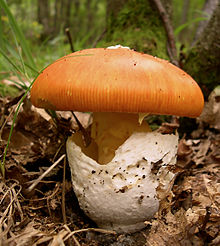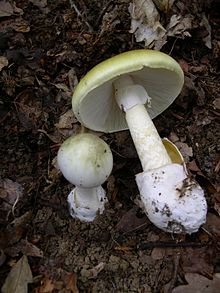
The genus Amanita contains about 600 species of agarics, including some of the most toxic known mushrooms found worldwide, as well as some well-regarded edible species. The genus is responsible for approximately 95% of fatalities resulting from mushroom poisoning, with the death cap accounting for about 50% on its own. The most potent toxin present in these mushrooms is α-Amanitin.

Amanita fulva, commonly called the tawny grisette or the orange-brown ringless amanita, is a basidiomycete mushroom of the genus Amanita. It is found frequently in deciduous and coniferous forests of Europe, and possibly North America.
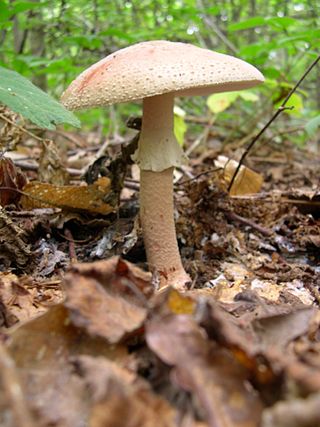
The blusher is the common name for several closely related species of the genus Amanita. A. rubescens, or the blushing amanita, is found in Europe and eastern North America, and A. novinupta, also known as the new bride blushing amanita, is found in western North America. Both their scientific and common names are derived from the propensity of their flesh to turn pink upon bruising or cutting.

Amanita cokeri, commonly known as Coker's amanita and solitary lepidella, is a poisonous mushroom in the family Amanitaceae. First described as Lepidella cokeri in 1928, it was transferred to the genus Amanita in 1940.

Amanita brunnescens, also known as the brown American star-footed amanita or cleft-footed amanita is a native North American mushroom of the large genus Amanita. It differs from A. phalloides by its fragile volva and tendency to bruise brown.

Amanita persicina, commonly known as the peach-colored fly agaric, is a basidiomycete fungus of the genus Amanita with a peach-colored center. Until c. 2015, the fungus was believed to be a variety of A. muscaria.

Amanita abrupta, commonly known as the American abrupt-bulbed amanita or the American abrupt-bulbed lepidella, is a possibly toxic species of fungus in the family Amanitaceae. Named for the characteristic shape of its fruit bodies, this white Amanita has a slender stem, a cap covered with conical white warts, and an "abruptly enlarged" swollen base. This terrestrial species grows in mixed woods in eastern North America and eastern Asia, where it is thought to exist in a mycorrhizal relationship with a variety of both coniferous and deciduous tree species.

Amanita daucipes is a species of fungus in the family Amanitaceae of the mushroom order Agaricales. Found exclusively in North America, the mushroom may be recognized in the field by the medium to large white caps with pale orange tints, and the dense covering of pale orange or reddish-brown powdery conical warts on the cap surface. The mushroom also has a characteristic large bulb at the base of its stem with a blunt short rooting base, whose shape is suggestive of the common names carrot-footed lepidella, carrot-foot amanita, or turnip-foot amanita. The mushroom has a strong odor that has been described variously as "sweet and nauseous", or compared to an old ham bone, or soap. Edibility is unknown for the species, but consumption is generally not recommended due its position in the Amanita subgroup Lepidella, which contains some poisonous members.

Amanita onusta, commonly known as the loaded Lepidella, the gunpowder Lepidella or the gunpowder amanita, is a species of fungus in the mushroom family Amanitaceae. It is characterized by its small to medium-sized fruit bodies that have white to pale gray caps crowded with roughly conical, pyramidal, or irregular gray warts. The stipe is whitish-gray with woolly or wart-like veil remnants, and at the base is a spindle- or turnip-shaped base that is rooted somewhat deeply in the soil.
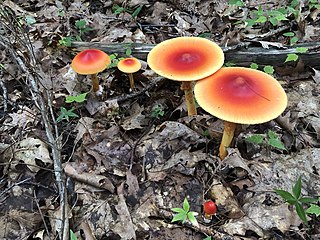
Amanita jacksonii, also known as Jackson's slender amanita, American Slender Caesar, and Eastern Caesar's Amanita, is a North American species of fungus in the family Amanitaceae. It is a reddish-orange colored mushroom species which can be identified by its yellow gills, large, white, sacklike volva.

Amanita rubrovolvata, commonly known as the red volva amanita, is a species of fungus in the family Amanitaceae. The fungus produces small to medium-sized mushrooms, with reddish-orange caps up to 6.5 millimetres wide. The stems are up to 10 cm (4 in) tall, cream-coloured above the ring and cream to yellowish below it. The stem ends in a roughly spherical bulb at the base, which is covered with bright orange patches.

Amanita crocea, the saffron ringless amanita, is a species of Amanita widely distributed in Europe. It is not recommended for consumption due to its similarity to poisonous species of the genus.
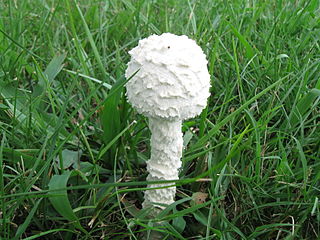
Saproamanita thiersii, commonly called Thiers' lepidella, is a North American saprotrophic basidiomycete fungus in the genus Saproamanita. It is a white, small mushroom. Its cap is convex, measuring 3.5–10 centimetres across, and the stipe is 8–20 cm (3–8 in) long. The spore print is white.

Amanita ceciliae, commonly called snakeskin grisette, strangulated amanita, and the Cecilia's ringless amanita, is a basidiomycete fungus in the genus Amanita. First described in 1854 by Miles Joseph Berkeley and Christopher Edmund Broome, it was given its current name by Cornelis Bas in 1984. It is characterized by bearing a large fruit body with a brown cap 5–12 cm (2.0–4.7 in) across. The cap has charcoal-grey patches, which are easily removable. The stipe is 7–18 cm (2.8–7.1 in) long, white in colour, and there is no ring on it. It is slightly tapered to the top, and has irregular cottony bands girdling the base. The universal veil is grey. Spores are white, spherical in shape, non-amyloid, and measure 10.2–11.7 micrometres. The mushrooms are considered edible, but field guides typically advise caution in selecting them for consumption, due to risks of confusion with similar toxic species. A. ceciliae is found in woods throughout Europe and North America, where it fruits during summer and autumn.
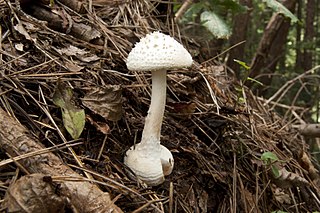
Amanita sphaerobulbosa, commonly known as the Asian abrupt-bulbed Lepidella, is a species of agaric fungus in the family Amanitaceae. First described by mycologist Tsuguo Hongo in 1969, it is found in Southern Asia.

Amanita pachycolea, commonly known as the western grisette or the Stuntz's great ringless amanita, is a species of agaric fungus in the family Amanitaceae.

Amanita excelsa, also known as the European false blushing amanita, is a species of agaric fungus in the family Amanitaceae. It is found in Asia, Europe, and North America, where it grows in deciduous forests.
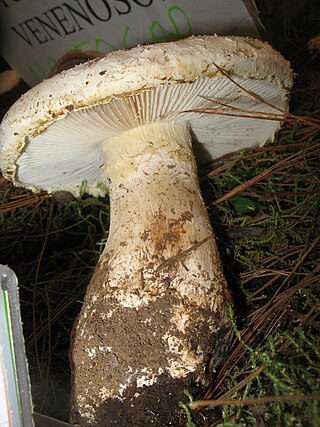
Amanita chlorinosma, also known as the chlorine lepidella or chlorine Amanita, is a North American species of Amanita. Its life cycle is perennial. It is easily distinguished by its strong unpleasant odor.

Amanita chrysoblema, with the common name American fly agaric, white variant, is a basidiomycete fungus of the genus Amanita. Although named chrysoblema, it is traditionally thought to be an Amanita muscaria variant, a group of fungi commonly known as fly agarics.

Amanita princeps, the head man slender Caesar, is a species of agaric fungus in the genus Amanita. It is found in tropical China, Southeast Asia, and the Malay Peninsula down to Singapore. It is edible, and is collected in the wild and sold in local markets. Many incidents of mushroom poisoning have occurred among Laotian and Hmong immigrants to North America, since it is easily confused with Amanita phalloides, the death cap, in both appearance and odor.

 Amanita albocreata – (North America)
Amanita albocreata – (North America) Amanita aliena – (south Brazil)
Amanita aliena – (south Brazil) Amanita altipes – (southwestern China) [5]
Amanita altipes – (southwestern China) [5]  Amanita aprica – (North America)
Amanita aprica – (North America) Amanita armeniaca – gypsy amanita (Australia)
Amanita armeniaca – gypsy amanita (Australia) Amanita augusta – USA
Amanita augusta – USA Amanita breckonii – western USA
Amanita breckonii – western USA Amanita chrysoblema
Amanita chrysoblema  Amanita eliae – (Europe)
Amanita eliae – (Europe) Amanita farinosa – (eastern North America to Central America)
Amanita farinosa – (eastern North America to Central America) Amanita frostiana – Frost's amanita (eastern North America)
Amanita frostiana – Frost's amanita (eastern North America) Amanita gemmata – gemmed mushroom, jewelled amanita (Europe)
Amanita gemmata – gemmed mushroom, jewelled amanita (Europe) Amanita gioiosa (Italy)
Amanita gioiosa (Italy) Amanita ibotengutake – Japanese Ringed-Bulb Amanita (Japan)
Amanita ibotengutake – Japanese Ringed-Bulb Amanita (Japan) Amanita multisquamosa - Small Funnel-Veil Amanita (eastern North America)
Amanita multisquamosa - Small Funnel-Veil Amanita (eastern North America) Amanita muscaria ** – fly agaric (cosmopolitan)
Amanita muscaria ** – fly agaric (cosmopolitan) Amanita nehuta – Maori dust Amanita (New Zealand)
Amanita nehuta – Maori dust Amanita (New Zealand) Amanita orientigemmata (Japan)
Amanita orientigemmata (Japan) Amanita parcivolvata – False Caesar, False Fly Agaric
Amanita parcivolvata – False Caesar, False Fly Agaric Amanita pantherina – panther mushroom, panther cap (Northern Hemisphere)
Amanita pantherina – panther mushroom, panther cap (Northern Hemisphere) Amanita parvipantherina – (Yunnan province, southwestern China) [5]
Amanita parvipantherina – (Yunnan province, southwestern China) [5]  Amanita persicina – Peach-Colored Fly Agaric
Amanita persicina – Peach-Colored Fly Agaric Amanita petalinivolva – (Brazil)
Amanita petalinivolva – (Brazil) Amanita pseudoregalis – (Europe)
Amanita pseudoregalis – (Europe) Amanita regalis – royal fly agaric (Europe, Alaska)
Amanita regalis – royal fly agaric (Europe, Alaska) Amanita roseotincta – North America
Amanita roseotincta – North America Amanita rubrovolvata – red volva amanita (Asia)
Amanita rubrovolvata – red volva amanita (Asia) Amanita velatipes – (eastern North America)
Amanita velatipes – (eastern North America) Amanita virgineoides – white-colored (Japan)
Amanita virgineoides – white-colored (Japan) Amanita viscidolutea – (Brazil)
Amanita viscidolutea – (Brazil) Amanita wellsii – salmon amanita (North America)
Amanita wellsii – salmon amanita (North America) Amanita xanthocephala – vermillion grisette (Australia)
Amanita xanthocephala – vermillion grisette (Australia) Amanita xylinivolva – cottony volva amanita (US, Mexico, Costa Rica, Colombia)
Amanita xylinivolva – cottony volva amanita (US, Mexico, Costa Rica, Colombia)
